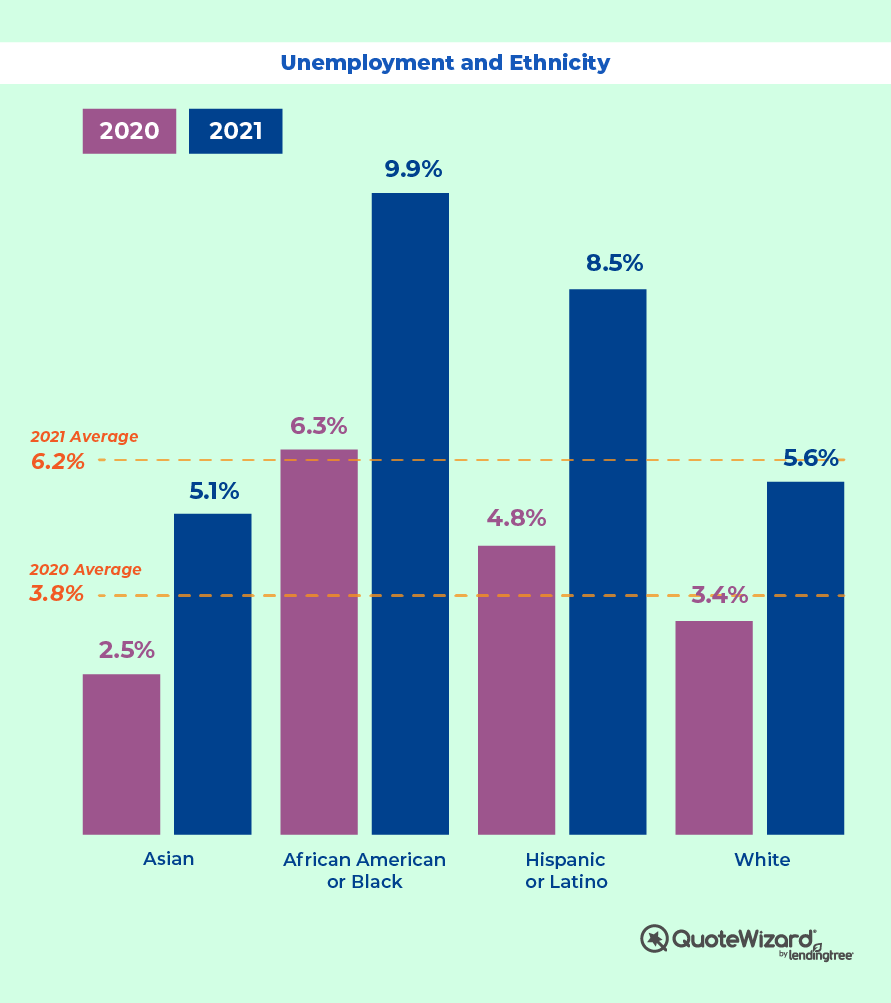It started with the number of COVID-19 cases. The coronavirus spread to every corner of the nation, but people of color were affected more — more likely to contract the virus, more likely to be hospitalized and more likely to die.
Then came the layoffs. In one year, the unemployment rate skyrocketed. And while some jobs have started to come back, the unemployment rate for people of color is still significantly higher than it is for white people.
Finally, there is the extra risk of exposure people of color have faced. Black, Hispanic and Asian people are more likely to be working in frontline or essential positions but less likely to be vaccinated. Nationwide, nearly 52 million people have been fully vaccinated, however, only 31% of them are people of color.
As we move into the second year of the coronavirus pandemic, our team of analysts took an in-depth look at the virus’s impact on people of color. In unemployment reports, in health surveys and on the frontlines, we found one constant: People of color have been disproportionately affected by the ongoing pandemic.
Key findings:
- Black and Hispanic Americans are 2.1x more likely to die from COVID-19 and nearly 3x more likely to be hospitalized.
- American Indians, Alaska Natives, Native Hawaiians and Pacific Islanders have the highest ratios of COVID-19 cases and deaths and the lowest numbers of people who are fully vaccinated.
- Despite making up nearly 40% of the population, only 14.9% of people who are fully vaccinated are Black, Hispanic or Asian.
- The unemployment rate for people of color has consistently been several percentage points higher than the unemployment rate for white people throughout the pandemic.
- People of color are 10-20% less likely to be able to work remotely or from home.
- Nearly 40% of all frontline workers are people of color.
At greater risk
Long-standing health and social inequalities have exposed people of color to more risk during the coronavirus pandemic. The number of people who have contracted or died from COVID-19 is significantly higher in the Black, Hispanic, Native American and Pacific Islander communities than it is among white people. These same communities have also had significantly less access to vaccines.
| Race or ethnicity | COVID-19 cases per 100,000 | COVID-19 deaths per 100,000 | % of people fully vaccinated | % of U.S. population |
|---|---|---|---|---|
| American Indian or Alaska Native | 8,139 | 172 | 1.60% | 1.30% |
| Asian | 3,152 | 95 | 4.00% | 5.90% |
| Black or African American | 5,822 | 178 | 7.10% | 13.40% |
| Hispanic or Latino | 7,572 | 154 | 7.40% | 18.50% |
| Native Hawaiian or Pacific Islander | 9,046 | 144 | 0.20% | 0.20% |
| White | 4,495 | 124 | 68.90% | 60.10% |
The statistics above, however, don’t fully show the risk many people of color have faced during the pandemic. According to the Centers for Disease Control and Prevention, people who identify as American Indian, Black and Hispanic are three times more likely to be hospitalized with coronavirus-related symptoms and twice as likely to die from the virus.
On the frontlines
One reason why people of color have higher COVID-19 case rates is because of their greater proportionate exposure on the frontlines of the pandemic. Black and Hispanic communities make up 31.9% of the population but nearly 33.3% of all essential workers. We also found that people who identify as Black and Hispanic are significantly less likely to be able to work from home.
| Race or ethnicity | % of total workers | % of frontline or essential workers | % of workers who can work from home |
|---|---|---|---|
| Asian Americans and Pacific Islanders | 6.60% | 6.70% | NA |
| Black or African American | 11.90% | 17% | 39.50% |
| Hispanic or Latino | 16.80% | 16.30% | 28.90% |
| White | 63.50% | 58.80% | 48.70% |
While many people of color have been working on the frontlines, many more have lost their jobs. The average unemployment rate for people of color was 4.3% in February of 2020. In February of 2021, it nearly doubled to 7.83%.

For many people of color, the issues highlighted above are no surprise. Unequal access to health care and unfair employment practices are long-standing inequalities. In order to address them, we must evaluate and change the systems currently in place. The ongoing pandemic has only accelerated these inequalities and made them even more dire to address.
Methodology:
QuoteWizard’s team of analysts evaluated six data sets to represent the unequal toll the coronavirus pandemic has had on people of color.
The first table was compiled using the most recent data from the Centers for Disease Control and Prevention’s COVID-19 data tracker.
For the second table, our analysts evaluated employment demographic data from the Center for Economic Policy and Research and remote work conducted by the United States Bureau of Labor Statistics (BLS).
Unemployment statistics for February 2020 through February 2021 were gathered through an analysis of BLS statistics.
References:
QuoteWizard.com LLC has made every effort to ensure that the information on this site is correct, but we cannot guarantee that it is free of inaccuracies, errors, or omissions. All content and services provided on or through this site are provided "as is" and "as available" for use. QuoteWizard.com LLC makes no representations or warranties of any kind, express or implied, as to the operation of this site or to the information, content, materials, or products included on this site. You expressly agree that your use of this site is at your sole risk.